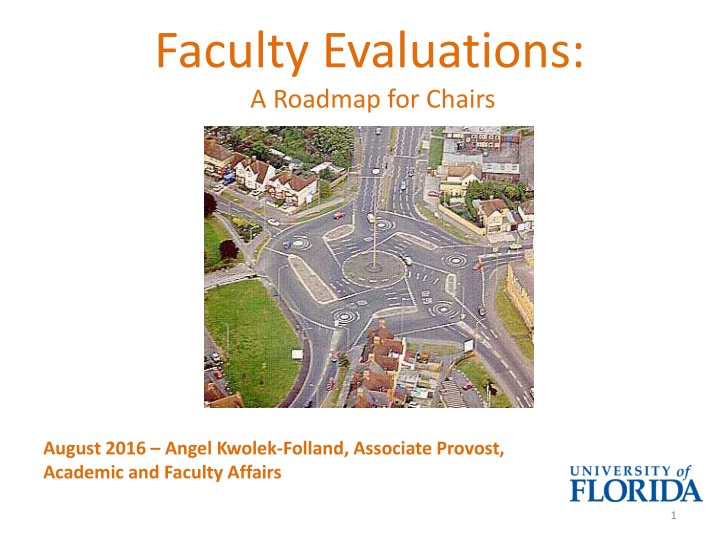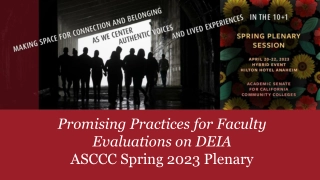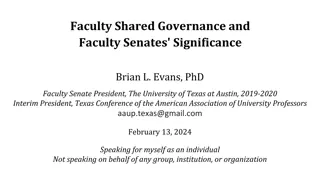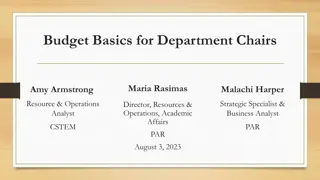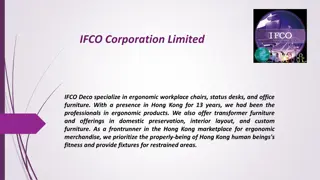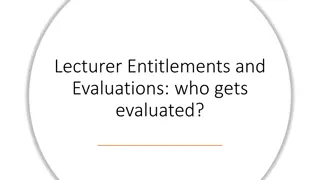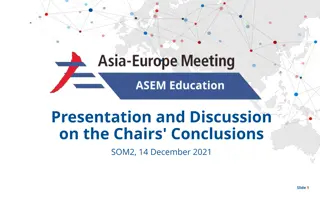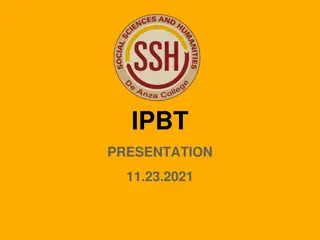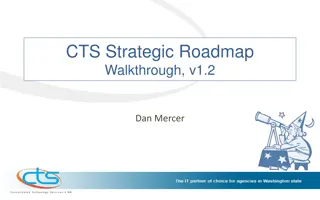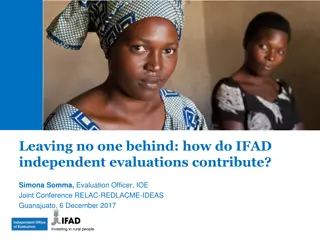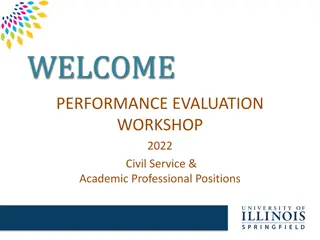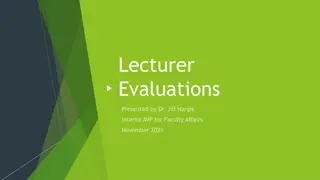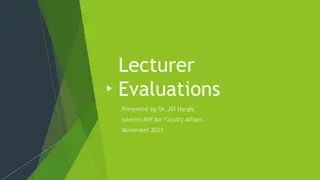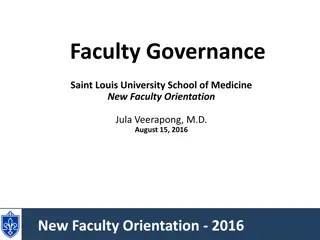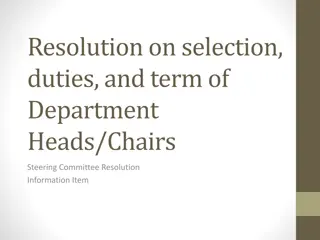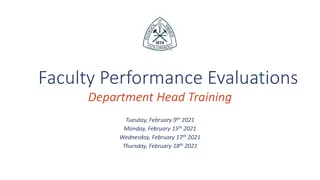Faculty Evaluations: A Roadmap for Chairs
In this August 2016 document by Angel Kwolek-Folland, Associate Provost of Academic and Faculty Affairs, guidance is provided on effectively conducting faculty evaluations. It offers a structured approach for department chairs to streamline the evaluation process, enhancing objectivity and fairness while ensuring compliance with institutional standards and goals. The roadmap includes best practices, tools, and strategies to facilitate constructive feedback, professional development, and performance improvement within academic settings.
Download Presentation

Please find below an Image/Link to download the presentation.
The content on the website is provided AS IS for your information and personal use only. It may not be sold, licensed, or shared on other websites without obtaining consent from the author.If you encounter any issues during the download, it is possible that the publisher has removed the file from their server.
You are allowed to download the files provided on this website for personal or commercial use, subject to the condition that they are used lawfully. All files are the property of their respective owners.
The content on the website is provided AS IS for your information and personal use only. It may not be sold, licensed, or shared on other websites without obtaining consent from the author.
E N D
Presentation Transcript
Faculty Evaluations: A Roadmap for Chairs August 2016 Angel Kwolek-Folland, Associate Provost, Academic and Faculty Affairs 1
Agenda The Chair and Faculty Evaluations Types of Evaluations 6 Tips on Evaluation Letters The Role of Evaluations in Discipline 2
Chairs and Evaluations Chairs do many things; maybe none more important than faculty evaluation. o It s important that for the time you are chair, you realize that it s not about you Chair is a role and people will interact with you in that role. Chairs annual and cyclical evaluation letters are very important in the P&T process, in SPE, and in disciplinary matters. Your colleagues, college committee, deans, the APB, president and SVPs rely on your insights and opinions. Keep in mind also that at the college and university level, P&T evaluators will be reading all of your letters and weighing them against one another. 3
Types of Evaluations Mid-term Evaluation Annual Evaluations P&T Evaluation Sustained Performance Evaluations 4
#1 - Annual Evaluations are Critical #1: Annual evaluations are key to many other actions. Evaluations point faculty to what they need to accomplish; can encourage, reward, or warn. If you have a faculty member who is not meeting expectations, address that in the annual evaluations. If you, or your predecessor, has given an under-performing faculty member a satisfactory evaluation for 5 years, it won t be easy to suddenly argue that they haven t been doing well all along. If you inherit a problem, get with your Associate Dean to develop a strategy to resolve. If the annual evaluations accurately capture the chair s assessment each year, the moments when change comes (tenure and/or promotion, discipline, etc.) will be easier for everyone. 5
#2 - Directive Language #2: Use language that is directive rather than permissive. Use language in annual evaluations that is specific and concise about expectations: You must increase your publications in first-tier journals instead of You might want to look at submitting more of your work to good journals. (It s hard to be directive with your colleagues; but as chair it s your job to do so.) Key the language of expectation to the language in the university, college and/or departmental criteria. The same is true of your P&T evaluation letter: Relate the points you are making about performance to specific areas of the criteria. If you ve done the annual evaluations right, this will be easy because you will have laid out the connections already. 6
#3 - YOUR Evaluation #3: It s YOUR evaluation You are the person who signs the letter, you are the one whose reputation is on the line. You can t hide behind summarizing or recapping what the committee or external evaluators said. If you lend support to an obviously weak case, you undermine your personal and professional credibility and call all your other judgments into question. Your job as chair is not to simply support the candidate, or mirror the support or lack of it by a committee. You are expected to exercise independent judgment, based on your evaluation of the dossier. Endorse the candidate only if you believe the candidate meets the criteria established by the university, college, department, and discipline. 7
#4 Letters: Unique #4: Individuality isn t always a good thing. For your annual and T&P letters, use a template. Everyone s letter should be as much the same as possible in the bones, with the muscle & fat shaped to individual strengths and weaknesses. Intro; a paragraph each on teaching, research, and service (or whatever is in assignment); conclusion. Always summarize your overall assessment at the end: Overall, your performance is satisfactory/unsatisfactory for the year or something similar. 8
#5 - Letters: Novels #5: Letters are not 19th century Novels Long letters are not automatically Good letters. Unlike Charles Dickens, you are not being paid by the word. Be clear and succinct: other evaluators have access to the same materials you do so you don t need to summarize them. What they want to see is what conclusion *you* have come to after reviewing the materials. Don t quote from the external evaluation letters; name no names or institutions. Use generalities or summarize everyone else can see and read the letters for themselves. I have seen brilliant, insightful letters of 1.5 not-very-dense pages. Those who are reading 250 files will appreciate conciseness. 9
#6 - Letters: Sci Fi #6: Letters are not Science Fiction Fantasy movies Your audience is smart and knowledgeable: be honest about the facts; don t sugar coat and don t denigrate when the facts say otherwise. You do not want other evaluators to read your letter and say, How can this chair say this person is a sterling teacher when the evaluations show he s been below the department and college mean 4 out of 5 years? You can explain the record if needed, but don t expect us to believe it s a train if it walks like a duck. 10
We Hope It Never Happens No one wants to see a colleague s appointment end or discipline imposed because of performance or behavioral issues. But it happens .and the chair will be involved if it does. Understand the processes; ostrich feathers will not look good on you. 11
Connecting Evaluation and Discipline Evaluations of faculty can encourage and reward achievement; but are also necessary in mitigating disasters. Evaluations are a key piece of equipment in the chair s toolkit. It is the piece most completely in the control of departments and colleges, and the first line of defense when bad behavior occurs. If the evaluation piece is right, the rest is much easier. AND . 12
You are not expected to do this alone . The following information is for professional drivers on a closed course . 13
Evaluation & Discipline The Total Picture Mid-term Review Investigations: EEO, HR, OAA, OIA, etc. Annual Evaluations Sustained Performance Evaluations Discipline Result: Termination Result: Changed Behavior Remediation Plan 14
Mid-Term Evaluation Tenure-Track Only Mid-term Review Stand-alone process not connected to discipline or termination; not used for evaluation or discipline. Part of tenure probationary period. Includes review at college level. 15
Annual & Sustained Performance Evaluations Annual Evaluations Sustained Performance Evaluations Result: Changed Behavior Result: Termination ? Remediation Plan 16
Unsatisfactory Annual Evaluation Untenured and non-Tenure-Track Annual Evaluations Result: Termination? 17
Results of Investigation & Discipline Investigations: EEO, HR, OAA, OIA, etc. Annual Evaluations Discipline Result: Changed Behavior Result: Termination 18
Evaluation, Investigation & Discipline The Total Picture Mid-term Review Investigations: EEO, HR, OAA, OIA, etc. Annual Evaluations Sustained Performance Evaluations Discipline Result: Termination Result: Changed Behavior Remediation Plan 19
Ending Faculty Employment Type of Appointment Reorganization; reallocation of resources; Incompetence or misconduct; non-renewal w/o cause; soft money Non-tenured and non- tenure track Reorganization; reallocation of resources; department abolished; unsatisfactory performance; just cause Tenure-track in unit Tenured Just cause 20
Ending Faculty Employment Sources For Just Cause Just Cause = Reg 7.048 Incompetence or Misconduct Termination of faculty employment, including tenured Just Cause = CBA 27 21
Examples of Incompetence or Misconduct Reg. 7.048(1)(a)-(p) (a) Neglect of duty or responsibilities which impairs teaching, research, or other normal and expected services to the University; (b) Failure to perform the terms of employment; (c) Willful violation of a rules or regulation of the University; (d) Failure to discharge assigned duties; (e) Conduct, professional or personal, involving moral turpitude; (f) Violation of the ethics of the academic profession; (g) Action(s) which impair, interfere with, or obstruct; or aid, abet, or incite the impairment, interference with, or obstruction of; the orderly conduct, processes, and functions of the University. (h) Failure to return from an approved leave; (i) Failure to maintain professional licensure or clinical privileges necessary to perform assigned duties; ( j) Threatening or abusive language or conduct; (k) Sexual harassment; (l) Falsification of records; (m) Unauthorized use of state property, equipment or personnel; (n) Possession, sale, distribution of alcoholic beverages or non-prescribed drugs; (o) Insubordination; (p) Possession of unauthorized weapons and/or firearms on university property. 22
Potential Steps: Ascending Order of Severity --Letter of Counseling Not subject to grievance --Written reprimand --Suspension with pay --Suspension without pay --Demotion to next lower rank with reduction in salary --Termination Discipline: Subject to grievance Note: Steps do not have to be taken sequentially, and the process can begin at any step, depending on the severity or nature of the issue. Follow-up: Annual Evaluation 23
Again, We Hope It Never Happens, but . Who Ya Gonna Call? Provost s Office: Angel Kwolek-Folland, Associate Provost for Academic and Faculty Affairs akf@aa.ufl.edu Human Resources: Kim Baxley, Director, Employee & Labor Relations kim- c@ufl.edu Brook Mercier, Associate Director, E&LR bmercier@ufl.edu General Counsel s Office: Ryan Fuller, Associate University Counsel ryanf@ufl.edu Or the Associate Dean or HR representative in your college 24
